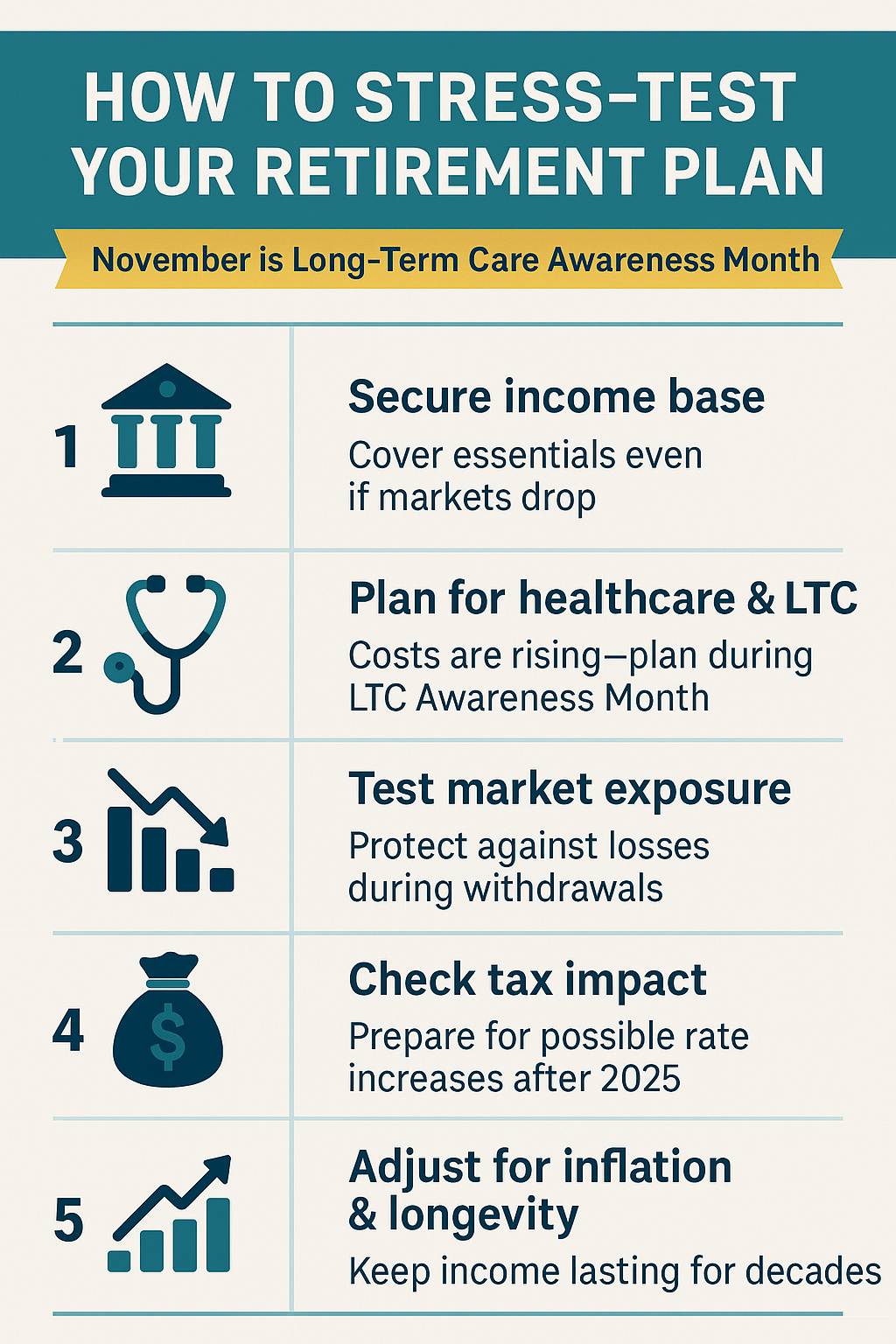How to Stress-Test Your Retirement Plan

Why Every Retirement Plan Needs a Stress Test
A strong retirement plan isn’t built for perfect conditions — it’s built to endure the unexpected. Market downturns, rising healthcare costs, tax changes, and life events can all impact your long-term security.
That’s why financial professionals often recommend a “retirement stress test.” It’s like a dress rehearsal for your future — showing how your plan performs under different real-world challenges, so you can adjust before problems arise.
And because November is Long-Term Care Awareness Month, it’s the perfect time to test how prepared your plan is for one of retirement’s biggest potential expenses: the cost of care.
1. Test Your Income Foundation
Start with your income basics — the money you rely on each month to cover necessities like housing, food, and healthcare.
Ask yourself:
“Could I still meet my essential expenses if the market dropped 20%?”
If not, it may be time to strengthen your income foundation.
This could include:
- Social Security and pensions
- Lifetime income annuities
- Reliable interest-based or dividend income
Your foundation should provide stability no matter what happens in the market.
2. Include Long-Term Care in the Equation
Most retirees underestimate how expensive care can be — and how quickly it can drain savings.
The national median cost for home health care, assisted living, or nursing homes can range from $60,000 to over $120,000 per year, depending on location and level of care.
Even if you never need long-term care, planning for it ensures your spouse or loved ones are financially protected.
Ways to plan ahead:
- Long-term care insurance: Traditional or hybrid life insurance with LTC riders.
- Annuities with care benefits: Provide income that can double or triple if care is needed.
- Savings allocation: Set aside a portion of assets specifically for potential care costs.
Long-Term Care Awareness Month serves as a reminder: preparing now helps avoid tough financial decisions later.
3. Evaluate Market Exposure and Risk
Your portfolio may not need to be aggressive to succeed — it needs to be consistent.
If too much of your retirement money depends on the market, a downturn could force you to sell at a loss just to meet expenses.
Try a simple “what-if” scenario:
- If your portfolio dropped 15–20%, how would that affect your income?
- Would you have to adjust your spending or delay withdrawals?
If yes, consider rebalancing — blending growth assets with more stable, income-producing options that protect principal and reduce volatility.
4. Check Your Tax Diversification
Tax rules evolve over time, and so should your strategy. Relying heavily on tax-deferred accounts (like IRAs or 401(k)s) can create higher tax bills later.
Ways to stress-test your tax exposure:
- Compare how much income is coming from taxable, tax-deferred, and tax-free accounts.
- Consider whether partial Roth conversions could make sense over time.
- Look for ways to reduce taxable withdrawals in high-income years.
A well-diversified tax plan helps you keep more of what you’ve earned — in any tax environment.
5. Plan for Inflation and Longevity
Retirement can last 25 years or more — and during that time, the cost of living can double.
Inflation quietly erodes purchasing power, especially for those living on fixed income sources.
A stress test should include projections for 2–3% inflation each year and the potential of living into your 90s.
You might find that:
- Your current plan lasts 20 years — but not 30.
- Small increases in guaranteed income or growth potential make a big difference.
The goal: Ensure your plan lasts as long as you do — not the other way around.
6. Protect Family and Legacy Goals
A comprehensive stress test doesn’t just focus on income — it also examines how your plan supports those you care about.
Consider:
- Will my spouse have enough income if I pass first?
- Have I outlined wishes for future care or medical decisions?
- Are my beneficiaries and estate documents current?
By planning for these details now, you protect your family from both financial and emotional strain later.
The Bottom Line
A retirement stress test is one of the most empowering exercises you can do. It’s not about predicting the future — it’s about preparing for it.
When your plan is flexible and tested against real-world risks like healthcare costs, taxes, and inflation, you can enjoy your retirement with greater confidence and peace of mind.
And since November is Long-Term Care Awareness Month, it’s a great time to make sure your plan includes a strategy for the care and comfort you may someday need.
🐾 Tootsie’s Takeaway
“Don’t wait for life to test your plan — give it a checkup now! A little preparation today keeps your future secure (and your tail wagging).”
Written by Brent Meyer, founder of SafeMoney.com. With more than 20 years of experience helping families navigate retirement and legacy planning, Brent is committed to making financial education simple, clear, and trustworthy.
Disclaimer: SafeMoney.com provides financial education only. For guidance on your specific situation, consult a licensed professional.









